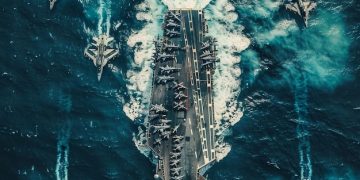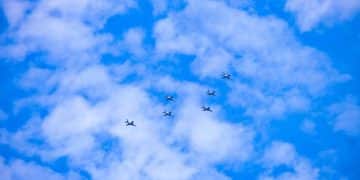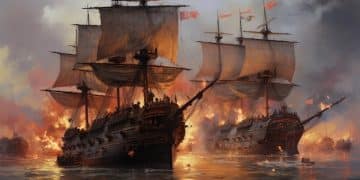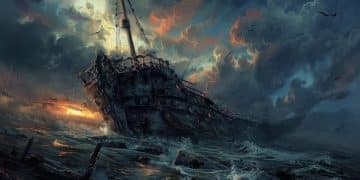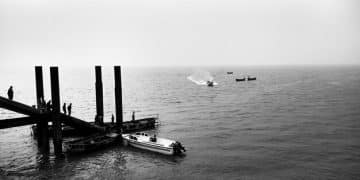Iwo Jima: Why Was This WWII Battle So Pivotal?
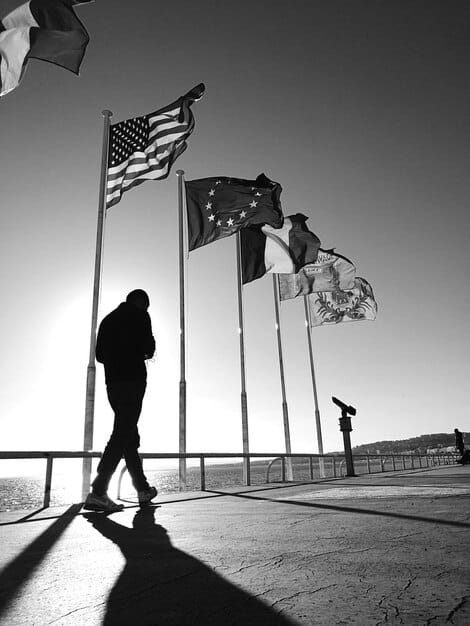
The Battle of Iwo Jima, a fiercely fought World War II conflict, was crucial due to the island’s strategic location, providing a vital airstrip for bombing Japan and a haven for damaged American aircraft.
The Battle of Iwo Jima: What Made This Island So Crucial in World War II? was one of the most brutal and pivotal engagements of the Pacific theater, a testament to strategic foresight and unrelenting combat. Understanding its importance requires delving into the geographical and military contexts of the time.
The Strategic Importance of Iwo Jima
Iwo Jima’s significance transcended its small size. Its location made it a critical asset for both the United States and Japan, each viewing the island as a key to achieving their objectives in the Pacific. Let’s explore why this volcanic island held such strategic value during World War II.
Geographic Positioning
Iwo Jima sits almost equidistant between Tokyo and the Mariana Islands, a chain of islands that included Guam and Saipan, which had already fallen under American control. This location made Iwo Jima strategically invaluable.
Airstrips and Bombing Campaigns
The island possessed three airstrips, one of which was operational. These airstrips were crucial for the US air campaign against Japan. Capturing Iwo Jima would allow American bombers to reach Japan more easily, while also providing a safe haven for damaged bombers returning from missions.
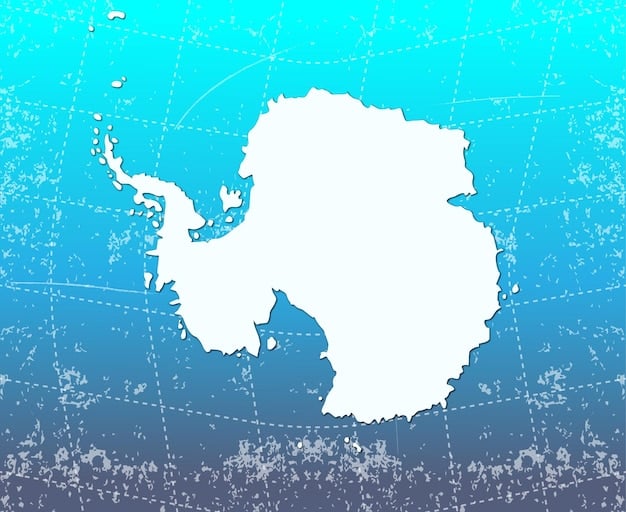
The strategic value of Iwo Jima can be summarized:
- Base for Long-Range Bombers: It served as a base for P-51 Mustang fighters, providing escort for B-29 bombers targeting mainland Japan.
- Emergency Landing Strip: Damaged bombers could land on Iwo Jima, preventing them from ditching in the ocean and saving countless lives.
- Disrupting Japanese Air Operations: Control of Iwo Jima would disrupt Japanese air operations and reduce their ability to intercept American bombers.
Ultimately, the United States recognized that capturing Iwo Jima was essential for intensifying the bombing campaign against Japan and bringing the war to a swifter conclusion.
The Japanese Defense Strategy
The Japanese were acutely aware of Iwo Jima’s strategic importance. They knew that if the island fell into American hands, it would serve as a launchpad for intensified bombing raids against their homeland. Therefore they were determined to make the Americans pay dearly for every inch of ground.
Fortifications and Underground Bunkers
Under the leadership of General Tadamichi Kuribayashi, the Japanese forces transformed Iwo Jima into a fortress. They constructed an intricate network of underground bunkers, tunnels, and reinforced positions, making the island a formidable defensive stronghold.
Attrition Warfare
Kuribayashi’s strategy was not to prevent American invasion but to inflict maximum casualties, hoping to break the American will to fight. The Japanese soldiers were ordered to fight to the death, and they did, with fanatical resolve.
The key elements of the Japanese defense were:
- Extensive Tunnel Systems: These allowed troops to move undetected and launch surprise attacks.
- Camouflaged Positions: Gun emplacements and bunkers were carefully camouflaged to blend in with the terrain.
- Limited Counterattacks: Kuribayashi forbade large-scale banzai charges, opting instead for a strategy of attrition.
The Japanese strategy succeeded in making the battle exceptionally costly for the Americans. The defenders extracted a heavy toll on the invading forces, prolonging the battle and making it one of the bloodiest engagements of the Pacific War.
The American Invasion Plan
The American invasion, codenamed “Operation Detachment,” was meticulously planned. The U.S. Navy and Marine Corps prepared for a protracted and challenging assault. The plan involved extensive предварительных бомбардировок и скоординированной совместной операции армии и авиации.
Naval Bombardment and Air Support
Before the Marines landed, Iwo Jima was subjected to intense naval bombardment and aerial bombing. The goal was to soften up the Japanese defenses and disrupt their ability to resist the invasion.
Amphibious Landing
On February 19, 1945, the first wave of Marines landed on the southeastern beaches of Iwo Jima. The initial landing was relatively unopposed, but as the Marines advanced inland, they encountered fierce resistance.
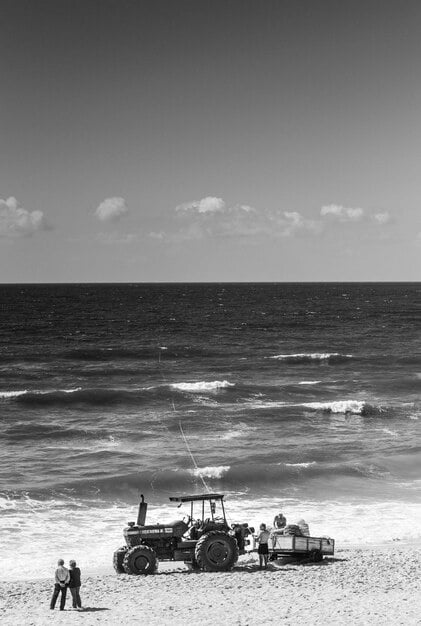
Key aspects of the American invasion included:
- Phased Assault: The invasion was planned in phases, with specific objectives for each phase.
- Close Air Support: Aircraft provided close air support to the Marines, attacking Japanese positions and providing reconnaissance.
- Naval Gunfire: Naval gunfire continued to support the Marines, shelling Japanese fortifications and disrupting enemy movements.
Despite thorough preparation, the Americans faced unexpectedly stiff resistance, leading to a grueling battle. The combination of the rugged terrain, the Japanese defenses, and the determined enemy made the operation exceptionally challenging.
The Battle on the Ground
Once the Marines were ashore, the battle for Iwo Jima became a brutal, yard-by-yard struggle. The Japanese defenders were deeply entrenched, and the terrain was incredibly difficult. Let’s delve into the harrowing details of the ground combat.
Mount Suribachi
One of the first objectives for the Marines was to capture Mount Suribachi, a dormant volcano at the southern tip of the island. The capture of Suribachi was strategically important because it provided a commanding view of the island and a location for observation and signaling.
Tunnels and Fortifications
The Marines faced relentless fire from hidden Japanese positions. The intricate network of tunnels and fortifications allowed the Japanese to appear and disappear at will, making it exceedingly difficult for the Americans to root them out.
The ground battle was defined by the following circumstances:
- Close-Quarters Combat: Much of the fighting took place at close range, often hand-to-hand.
- Heavy Casualties: Both sides suffered heavy casualties, with Marines struggling to overcome the Japanese defenses.
- Flame Throwers and Explosives: Flame throwers and explosives were used extensively to clear out Japanese bunkers and tunnels.
The American forces gradually gained ground, but at a heavy price. The battle was characterized by its intensity, the determination of both sides, and the harrowing conditions under which it was fought.
The Raising of the Flag
One of the most iconic images of World War II is that of the American flag being raised on Mount Suribachi. This event has come to symbolize the entire battle and the sacrifices made by the American forces. The photograph captured the spirit of resilience.
Symbolism of the Image
The photograph of the flag raising, taken by Joe Rosenthal, quickly became a symbol of American determination and resolve. It was widely circulated and used to promote the war effort. It inspired hope and a sense of national unity.
The Second Flag Raising
Interestingly, the flag raising captured in the iconic photograph was actually the second flag raising on Mount Suribachi. The first flag was deemed too small, so a larger flag was raised later that day. It was the second flag raising that Rosenthal photographed.
Key points of the flag raising included:
- Inspiration: The image inspired Americans and rallied support for the war effort.
- Recognition: The photograph earned Joe Rosenthal a Pulitzer Prize.
- Memorial: The image became the basis for the Marine Corps War Memorial in Arlington, Virginia.
The raising of the flag on Iwo Jima served as a powerful symbol of American triumph amidst the brutal realities of war. Its enduring impact continues to resonate in the collective memory of World War II.
The Aftermath and Legacy
The Battle of Iwo Jima officially ended on March 26, 1945, but its impact and legacy endure. The island’s capture had significant consequences for the war in the Pacific, and the battle remains a subject of study and remembrance.
Impact on the War
The capture of Iwo Jima provided the Allies with a crucial airbase and allowed for more intensive bombing of Japan. It also saved the lives of many American airmen who were able to land on the island after being damaged during bombing raids.
The Price of Victory
The battle was incredibly costly, with both sides suffering heavy casualties. More than 6,800 Americans were killed, and over 19,000 were wounded. The Japanese lost over 20,000 soldiers, with only a handful surrendering. This fierce resistance showed the resolve of the Japanese army during the war.
The legacy of the Battle of Iwo Jima encompasses:
- Strategic Victory: The island’s capture was a strategic victory that contributed to the eventual defeat of Japan.
- Sacrifice: The battle serves as a reminder of the sacrifices made by the soldiers and Marines who fought there.
- Historical Memory: The battle continues to be studied and remembered as one of the most significant engagements of World War II.
The Battle of Iwo Jima remains a testament to the courage, determination, and sacrifices of those who fought in the Pacific Theater. Its effects on the war as a whole can never be forgotten.
| Key Point | Brief Description |
|---|---|
| 📍Strategic Location | Midway between Japan and the Marianas, essential for air operations. |
| 🛡️ Japanese Defense | Extensive fortifications and tunnels created a formidable defensive network. |
| 🇺🇸 American Objective | Capture Iwo Jima to support bombing campaigns and provide a haven for damaged aircraft. |
| 🚩 Flag Raising | Iconic symbol of American resolve and sacrifice during the battle. |
Frequently Asked Questions
▼
Iwo Jima was heavily defended because it was crucial for Japan’s defense. Losing Iwo Jima would expose the Japanese mainland to intense bombing raids. The Japanese forces, therefore, fortified the island extensively, creating a major challenge for the U.S. forces.
▼
The battle was challenging for the American forces due to the intricate tunnel systems and fortified positions built by the Japanese. The Marines faced unrelenting fire from hidden emplacements, making every advance costly. The difficult terrain also contributed to the hardships.
▼
The capture of Iwo Jima allowed the Americans to launch long-range bombing raids against Japan more easily. It also provided a safe landing place for damaged bombers returning from missions. This significantly intensified the air war against Japan, contributing to the end of conflict.
▼
General Kuribayashi’s strategy was to inflict maximum casualties on the American forces rather than trying to prevent the invasion. He aimed to erode their will to fight, hoping for more favorable peace terms. He ordered his troops to fight to the death, making every American advancement brutal.
▼
The flag raising on Mount Suribachi became an iconic symbol of American courage and determination during World War II. The photograph of the event captured the spirit of resilience and triumph amidst great adversity, galvanizing support for the war effort back home.
Conclusion
In conclusion, the Battle of Iwo Jima was a brutal struggle for a strategically vital island, essential for the US war effort against Japan. The fierce resistance of the Japanese forces and the heavy casualties on both sides underscored the high stakes of this pivotal clash in the Pacific Theater.
